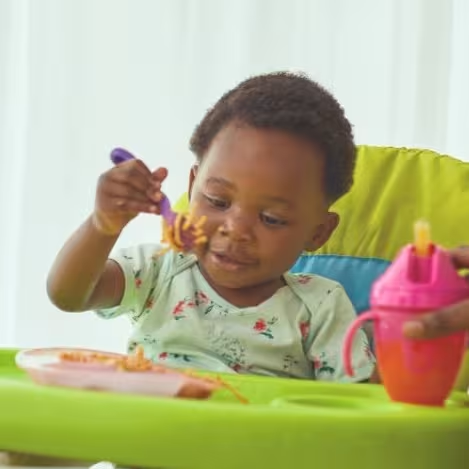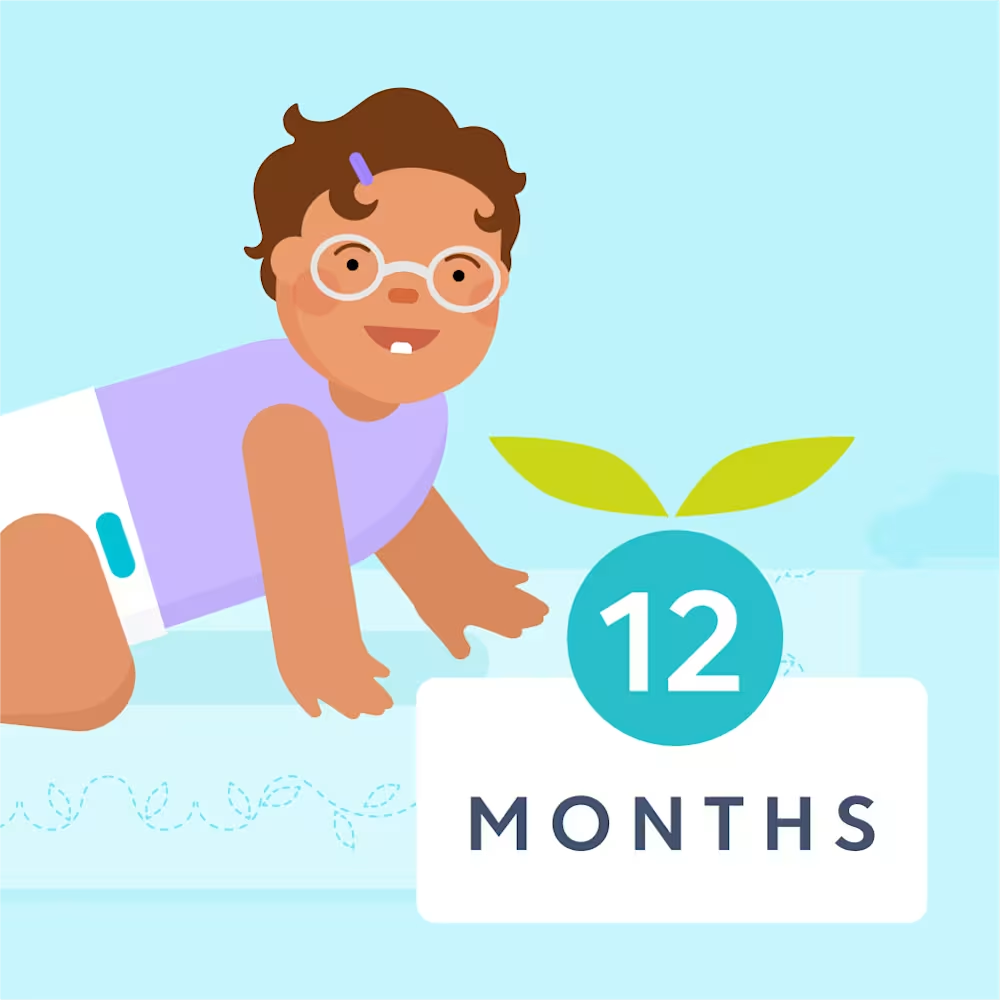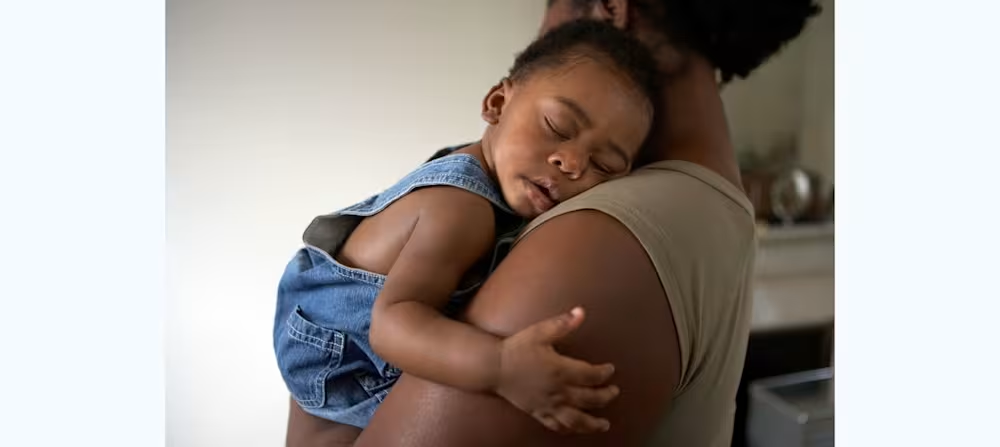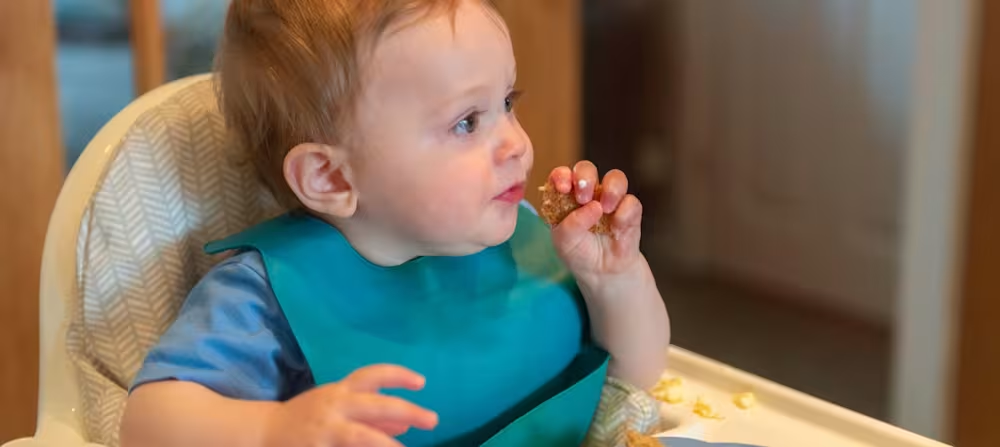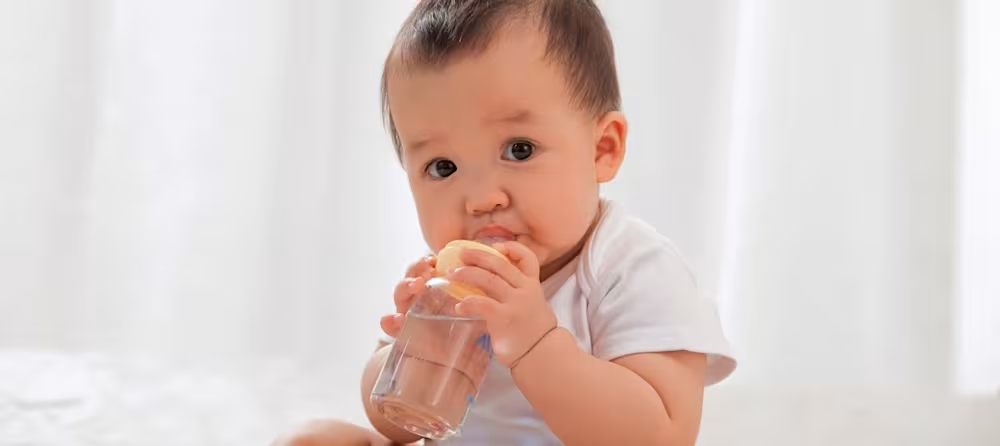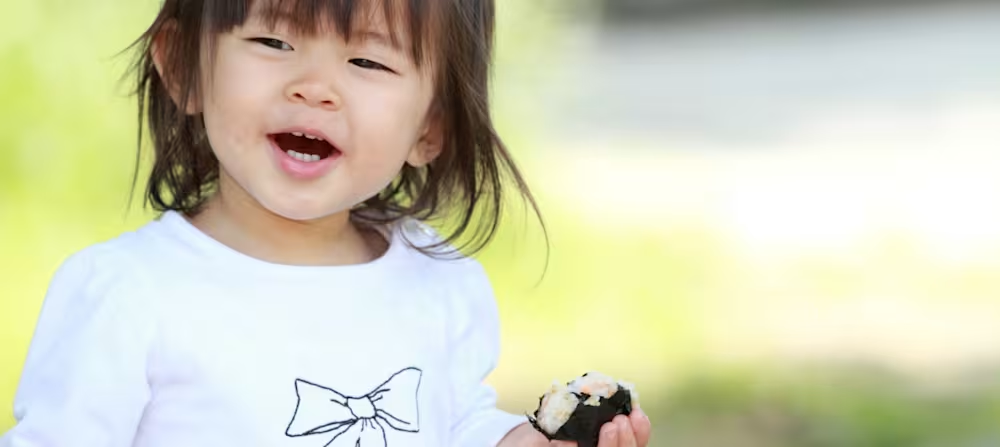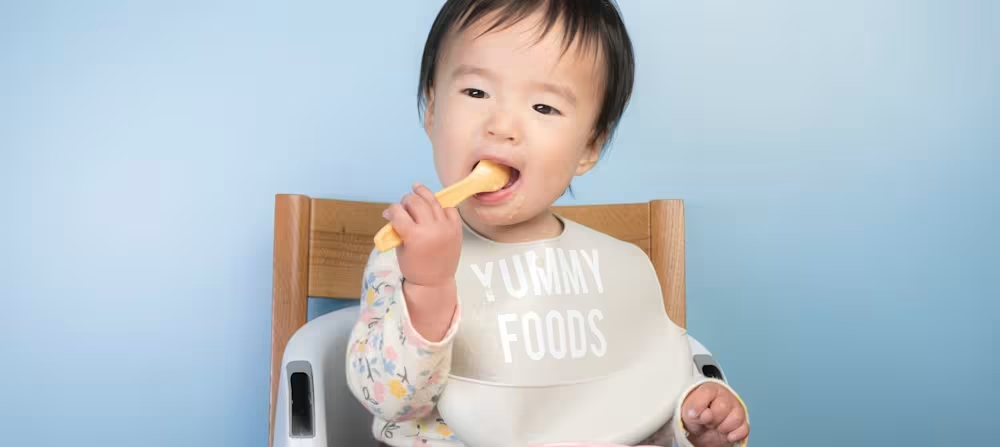1 year old baby milestones: Development, growth, speech, language
Updated Dec 29, 2025
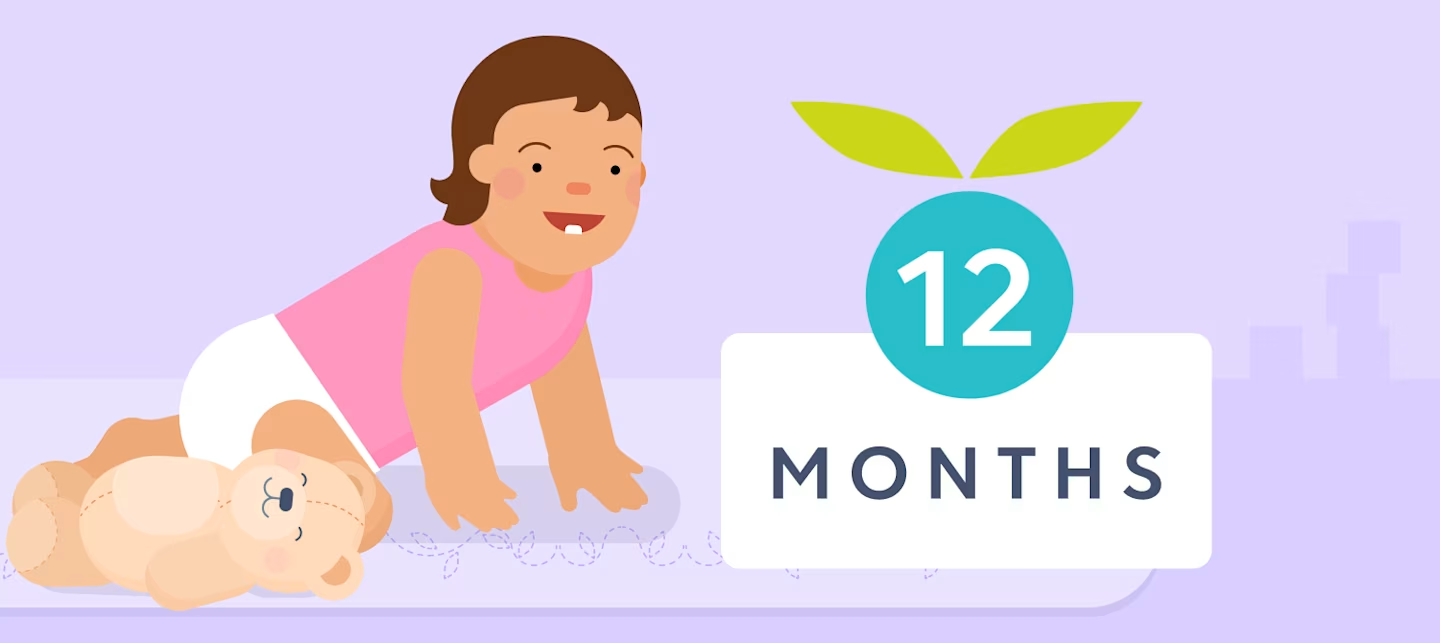
Happy first birthday to your little one! As you reflect on how much your child has already grown over their first year, rest assured there’s so much to look forward to in the coming year as well. Between 12 - 24 months, children usually learn to walk, say their first words, transition to a mostly solid food diet, and so much more.
In this article, we’ll take you through the milestones you can expect from 1 year old babies, give you a handy 1 year old development checklist, and provide useful tips to help ensure your little one is learning and growing as much as possible.
Editor's note
When we discuss babies and development at Huckleberry, we use their adjusted age (vs. actual age). Not all children will reach 1 year old milestones simultaneously — and that’s normal. There’s a wide spectrum when it comes to how fast toddlers grow and develop. While many children do reach these milestones between 12 and 24 months, this isn’t always the case. If you have any concerns or questions about your child’s development, reach out to their pediatrician.
Table of Contents
1 year old baby milestones at a glance
Development:
Between 12 - 24 months, toddlers are going through many big physical, verbal, and emotional changes. 1 year old gross motor milestones include toddlers learning to stand and walk independently, giving them increased independence (and eventually speed!). On the 1 year old speech development front, 12 month olds are typically working on their first words. By 24 months, most toddlers have a vocabulary of 100+ words!
Your little one will likely hit some banner milestones at 1 year, but keep in mind there’s a wide spectrum of normal for abilities like walking and first words. While it can be easy to compare your child to others, kids learn and grow at their own pace. However, if you do have concerns about your 1 year old’s development, be sure to communicate with their healthcare provider.
Sleep:
At 12 months old, around 13.25 hours of total sleep in a 24-period. This typically looks like 11 - 12 hours overnight with 2 - 3 hours of daytime sleep split over 2 naps. Most kids can stay awake about 3.25 - 4 hours between sleep periods while on a 2-nap schedule.
Most toddlers will then transition from a 2-nap to a 1-nap schedule . This generally requires your little one to stay awake at least 5 hours before and after their one daily nap. Some signs that your child may be ready to drop to 1 nap include: resisting naps (especially the second one of the day), sudden night waking, split nights (where they can’t sleep for long periods overnight), skipping naps, and regularly getting less than 10 hours of sleep overnight when taking two naps.
During this 1-nap transition, it may take some time for daytime sleep to lengthen to 2 - 3 hours — this is common! Sleep is often bumpy during periods of change. In general, there’s also a wide range of normal when it comes to toddler sleep totals. These numbers are a rough guide and it’s best to pay attention to your child’s mood and energy levels when evaluating if they’re getting enough daytime and overnight sleep.
You may also be wondering if 12 month olds can sleep through the night [] at this age if they aren’t already. In general, if a 1 year old has strong , gets enough calories and is active throughout the day, and has a reasonable bedtime, they can likely sleep 11 - 12 hours overnight without calling out for assistance or needing a feeding.
If you’d like personalized sleep guidance for your little one, consider submitting for a sleep plan through . Our step-by-step plans are tailored to your child’s needs as well as your family’s goals. It’s never too late to improve sleep habits!
Feeding:
After their first birthday, babies can move away from depending on formula and/or breast milk as their . Solid food will make up most of their diet at this age and the American Academy of Pediatrics (AAP) [] recommends offering 3 meals and 2 snacks per day. This doesn’t have to happen overnight, though! A slow transition to a mostly solid food diet usually produces the best results.
Breastfeeding offers benefits at this age as long as you and your child wish to continue nursing. Nursing sessions will likely slowly decrease as well as the goal is for your toddler to get most of their nutrition from solid foods. The AAP also recommends phasing out bottles [] between 12 - 18 months in favor of using cups. Prolonged bottle feeding can lead to issues like cavities and skipping solid meals.
At 12 months, it’s safe to introduce cow’s milk (or a milk alternative) to your little one. Cow’s milk contains important nutrients like calcium, vitamin D, vitamin A, zinc, and protein that will help your toddler grow and develop as they move away from a liquid diet. Whole milk is recommended for children under 2. The AAP suggests [] up to 2 - 3 cups (16 - 24 oz) of cow’s milk per day for 1 year olds, though children closer to 12 months will likely drink less milk than this.
In general, you may notice a sharp drop in your 1 year old’s appetite [], causing them to eat less than they had been previously. This is normal and usually not a cause for concern. Around 12 months, a child’s growth rate slows and they don’t require as much food to meet their changing energy needs.
Physical growth:
You may be used to your little one growing quite a bit over the course of a month or two. However, during the second year of life, growth slows down [] and your child may gain about 5 pounds and grow 4 - 5 inches in height over the course of the entire year. Most children have reached half of their adult height by the time they turn 2!
Your toddler may change a lot in appearance this year and not look so baby-like. Their body proportions [] and round bellies are beginning to change as they start to trim down and gain muscle due to their increased activity. It’s amazing to see how much your 1 year old physically grows and changes over the course of the year, though the fact that it’s happening so fast can be bittersweet!
Also, note that it can be normal for your little one to grow more or less than this between 12 - 24 months. At well-child visits, your child’s doctor will continue to chart their height and weight gain to check that they’re growing at a regular pace. This helps doctors pinpoint any health trends that need attention. If you have concerns about your toddler’s health at 1 year, consult their pediatrician.
12 to 24 month old development milestones
Physical development
Gross motor milestones
Crawling: At 12 months, most little ones are doing some form of crawling [], whether it’s classic hands-and-knee crawling or another version of creeping or scooting. And some kids never crawl! However, the AAP suggests [] letting your child’s doctor know if they are not crawling by their first birthday or dragging one side of their body while crawling (for more than a month).
Walking and running: Are you asking yourself, "" Well, your toddler is likely working on a version of walking! By 12 months [], most children are able to walk while holding onto furniture (called cruising). They may stand momentarily on their own and some may even be able to take 2 - 3 steps without support at this age. The walking milestone has a wide range of normal and is generally expected between 10 - 18 months []. The AAP suggests [] reaching out to your child’s pediatrician if they cannot walk by 18 months. By the age of 2, most kids are starting to run [] and can also carry toys or pull them while walking.
Changing positions: By 12 months, toddlers can typically get into a sitting position without assistance []. They can typically also transition from sitting to a crawling stance or a prone (lying on their belly) position.
Fine motor milestones
Manipulating objects: 1 year olds can use their hands in exciting new ways []. At this age, toddlers can bang two blocks together, put objects into a container, take objects out of a container, and let go of objects voluntarily. As your child gets closer to the age of 2, they may be able to build a tower [] of four blocks or more as hand-eye coordination continues to improve.
Scribbling: Your little one’s first masterpiece is on the horizon! At around 12 months, most children try to imitate scribbling. By the time they reach the age of 2, your child will likely be able to scribble spontaneously.
Speech development
First words: If you’re anxiously awaiting your child’s first word, note there’s a large range of normal for 1 year old language development. Some kids say 2 - 3 words [] by their first birthday but it’s perfectly normal if your little one’s speech is mostly gibberish at this age. If they are experimenting with sounds that have similar tones, intensities, and pitches to intelligible speech, those are signs your child is getting ready to talk. Respond to your toddler when they’re making these sounds — as if you’re having a conversation — in order to encourage them to continue making them. Most toddlers are able to say several single words by 15 - 18 months []. Around 2, toddlers are usually able to use simple phrases (like “more milk”) and speak in sentences consisting of 2 - 4 words. They can usually say around 100 or more words [] by their second birthday. If your child doesn’t speak 15 words by 18 months, the AAP recommends [] bringing this up with their doctor.
Gestures: By 12 months [], your child will likely be able to use simple gestures like shaking their head for “no,” waving, and pointing. The use of gestures typically evolves over your baby’s second year. By the age of 2, little ones can usually use more advanced gestures [] like blowing a kiss and nodding “yes.”
Imitating: 1 year old speech milestones also include toddlers trying to imitate words [] and gestures. This is part of their expressive language development and it’s pretty cute!
Learning body parts: Toddlers are learning the names of their body parts around their first birthday. Between 12 - 15 months, most children can identify 3 body parts by pointing to them when you ask a question like, “Where’s your nose?” In this younger age range, it’s unlikely they’ll be able to say the name of the body part too.
Social development
Emotional development
People preferences: 1 year old emotional development means your little one may shed some tears when you leave. They may be shy around strangers too. Toddlers are developing preferences [] for certain people at this age and it’s normal for them to be upset if you’re not with them. However, at this age, children are also starting to understand that when their parents leave, they always return. Typically separation anxiety begins
Favorite toys: It’s common for children to have favorite toys [] at the age of 1. Transitional objects, such as a blanket or stuffed animal can help provide reassurance and make it easier for little ones to separate from their parents at night when it’s time to sleep.
Requesting parental attention: Toddlers are figuring out how to get your attention at this age. This could look like bringing you a book [] when they want to hear a story or repeating sounds to get your attention. They are also typically starting to test parental reactions [] to things like throwing food and crying when you leave the room. Closer to 2 [], children may look at your face to see how to react in a new situation and they will likely notice when someone else is hurt or upset. class
1 year old development milestones checklist
Keep in mind children don’t all learn and grow at the same rate. Most toddlers will reach these milestones by 12 - 24 months, but that may not always be the case as there’s a wide range of normal when it comes to growth and development. However, you know your child best and if you are concerned about your 1 year old’s developmental milestones, reach out to their healthcare provider.
Does a version of crawling
Walks while holding furniture
May stand and take steps alone
Gets into a sitting position without help
Manipulates objects with their hands
Imitates scribbles at 12 months, scribbles spontaneously closer to 2
Experiments with noises that sound like intelligible speech
May say 2 - 3 words at 12 months, says 15+ words at 18 months
Uses and imitates gestures
Learns 3 body parts by 12 - 15 months
Develops preferences for people and toys
Requests attention from parents using sounds and actions
What are 12 month old development red flags?
Not all 12 month olds will reach milestones at the same pace and that's expected. There's a range of normal when it comes to physical and cognitive development. However, there are some instances that may warrant a closer look. Reach out to your child's pediatrician if you notice your child []:
Is not crawling
Is unable to stand even with support
Does not look for objects hidden from view while watching
Does not use pointing to indicate interest
Has not learned simple gestures like waving or shaking their head “no.
Does not say single words such as “mama” or “dada”
Has lost skills they previously had
3 development tips for 1 year old babies
Tip | Why it helps | How to put it into practice |
|---|---|---|
Chat, read, and sing together | Hearing lots of words builds your child’s language foundation and helps them connect sounds to meaning. | Narrate your day, point out what you see in books, and sprinkle in songs during routines. |
Use real words when you respond | Modeling the complete word helps your toddler gradually shift from “starter sounds” to clearer speech. They learn by hearing you say things the right way, over and over. | If they say “ba” for “ball,” you can reply, “Yes, that’s your ball!” Keep the tone positive and natural — you’re simply giving them the correct version to learn from. |
Invite them to be your helper | Being part of simple tasks builds confidence, supports early comprehension, and boosts their ability to follow directions as they approach age 2. | Let them hand you items, toss clothes into a basket, or help stir (with supervision). Keep directions simple: “Put this in the bin,” or “Bring me the sock.” Celebrate their efforts. |
Find more details below:
Tip #1: Talk, read, and sing
Exposing your little one to lots of words is one of the best ways you can encourage their 1 year old speech development. You can do this by talking, reading, and singing as much as possible. Boost book time by pointing to objects and people and asking your child to do the same. Use songs like “Head, Shoulders, Knees, and Toes” to keep them engaged and teach them new words and body parts. Make learning language fun!
Tip #2: Use the correct names for things
It’s normal for your 1 year old to use an approximation when they’re learning a word (like “ba” for “ball”). However, when you’re responding to them, say the word correctly. For example, if your toddler says “wa-wa” for “water,” respond by saying something like, “Yes! You want your water.” Eventually, this can help them learn to say the word correctly too.
Tip #3: Let your little one help
Your little one can be a big “helper”! Try including them in simple household tasks to give them a sense of importance and also expose them to more words and how things work. Closer to the age of 2, children are learning to follow simple instructions [] so small tasks around the house are a good way to promote this skill along with language comprehension.
Activities for a 12 month old
1. Offer buckets and baskets
1 year olds are entertained by simple toys and games. You may be surprised by how much they enjoy putting blocks and toys into a basket and then dumping them out again. This activity can [] also aid brain development and 1 year old fine motor milestones. Play will evolve as children get closer to 2 and begin to be able to sort shapes and colors [].
2. Introduce art time
Supply your 1 year old with non-toxic, washable art supplies, and let them go to work! Closer to 12 months your little one may not do too much with markers and crayons but by closer to 24 months most children are able to spontaneously scribble. Be sure to date the back of your child’s artwork so you can look back and see how far they’ve come as their skills develop.
3. Encourage adventurous eating without pressure
It’s normal for toddlers to have unpredictable, erratic eating behaviors []. They may love a food for a week straight then refuse to touch it again. Or they may eat a gigantic breakfast and then hardly touch their meals the rest of the day. As frustrating as these things may be, they are normal eating patterns for 1 year olds!
Your child’s diet will typically balance out over a couple of days if you continue to offer wholesome meals and try to avoid pressuring them to eat. Research shows [] that pressuring children to eat often contributes to picky eating and can lead to further negative eating behaviors in the future. []
Caring for a sick 12 month old
Your little one is becoming more active, curious, and communicative — but when they're sick, those busy days can slow down. Common colds, ear infections, and other minor illnesses are still frequent as their immune system continues to develop. When children are under the weather, being flexible and layering in comfort and support are helpful, especially when it . Try more tips for those sick days:
Keep your kiddo hydrated: Staying hydrated is key, especially when little ones are sick. If they’re not drinking as much at once, offer smaller, more frequent sips. Hydration also comes from food, but if they’re not interested in eating solids, that’s OK too.
Relieve congestion: A cool-mist humidifier, saline drops, and gentle suction can help clear a . Try to ease congestion before naps and bedtime so they can rest more comfortably.
Check for fever: A temperature of 100.4°F (38°C) or higher is considered a fever. If approved by your pediatrician, you can use infant or children’s Tylenol or Motrin. Avoid cough and cold medicines, as they are not safe for young children.
Adjust sleep expectations: Illness can cause extra tiredness or more frequent night waking. Follow their lead when it comes to rest, and return to your regular schedule once they’re feeling better.
Offer comfort: Some toddlers want extra cuddles and closeness when sick, while others prefer a bit more space. Pay attention to their cues and respond in the way that helps them feel secure and supported.
When to seek help
If your child has a fever for more than 24 hours or it reaches above 104°F (40°C), call their doctor right away. These can be signs of a more serious infection or illness and it's best to rule out anything that needs medical attention.
In general, if something feels off or you’re worried about how your child looks or acts, it’s safest to check in with their doctor. And if you already talked to them but symptoms appear worse, that’s a good time to check back in too.
Takeaway: Development milestones for 1 year olds
Your 1 year old is learning so many new skills! Most children at this age are already doing a version of crawling (though some never crawl) and are currently working on skills that will help them walk in the near future. It’s a big year for gross motor skills as by 24 months they will likely be running and able to jump too.
1 year old speech development typically includes your little one’s first word(s)! Young toddlers are expected to be babbling often and their sounds usually follow the patterns and tones of intelligible language at this age. They’re working on mimicking the way you talk! You may have some pretty animated “conversations” with your child at this age especially as they get closer to 2 and can usually say 100+ words and speak in simple phrases.
The aim is for children to transition to a mostly solid food diet at around 12 months. This may coincide with a sharp drop in your little one’s appetite and that’s OK. At this age, a child’s growth slows and they don’t require as many calories per day as they did before. Continue to offer a wide variety of foods and let your child decide what and how much to eat.
These are general guidelines for development from 12 - 24 months. It’s OK if your toddler isn’t doing all of these things between 1 - 2 years old as there’s a wide range of normal for most milestones. However, consult with your child’s healthcare provider if you notice any 1 year old developmental red flags or delays.
If you’re curious about what lies ahead when it comes to development, check out what you may expect when your little one is a . Take a look back at how far your baby has come by revisiting what they may have been like as an .
1 year old development milestones FAQ
Share article:
Note: The content on this site is for informational purposes only and should not replace medical advice from your doctor, pediatrician, or medical professional. If you have questions or concerns, you should contact a medical professional.
14 Sources
Table of Contents
Share article:

